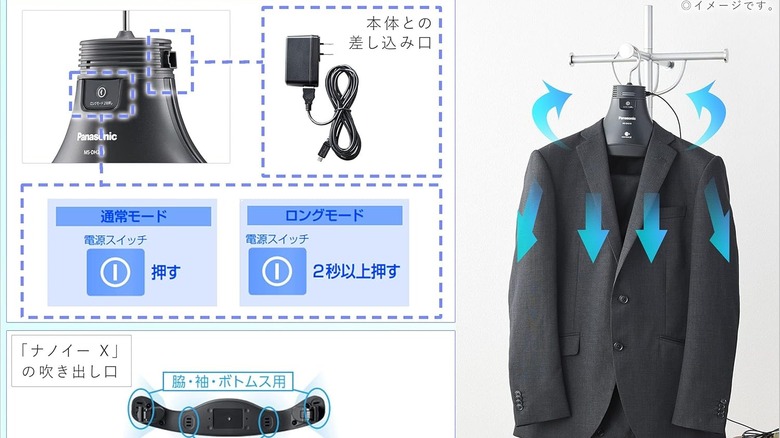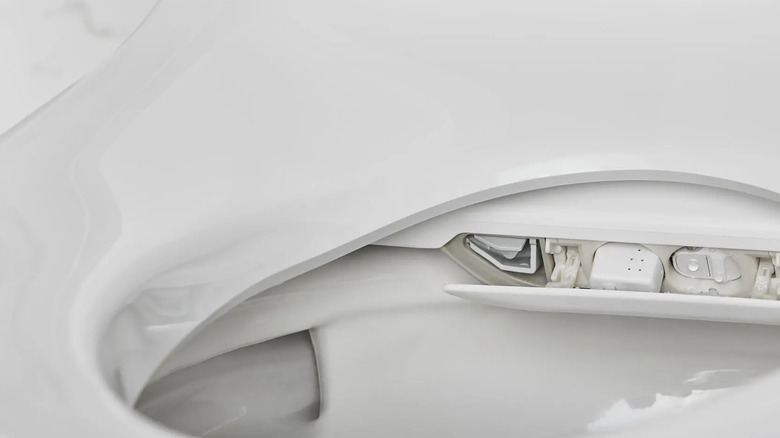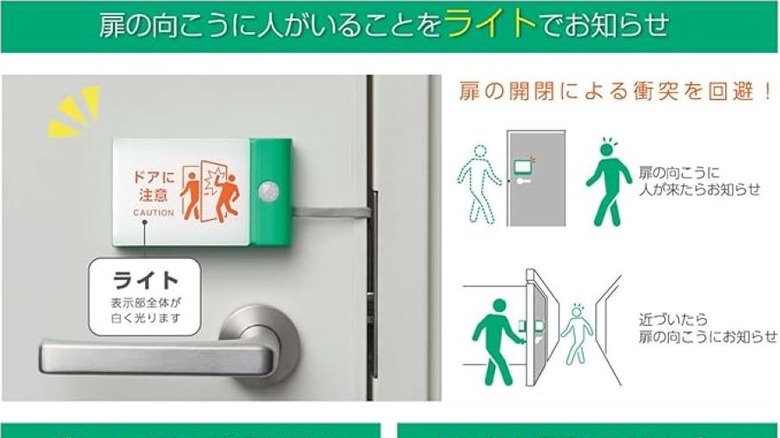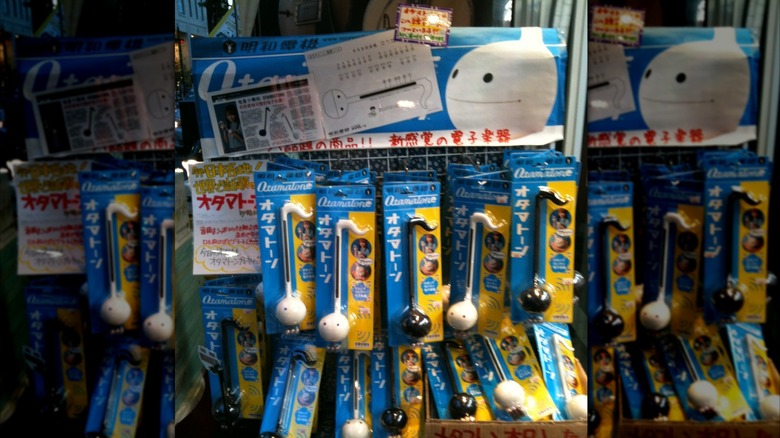10 Awesome Pieces Of Japanese Tech You Didn't Know Existed
We may receive a commission on purchases made from links.
Every developed nation has a unique approach to creating electronic products, but Japan's innovation and creativity take it to the next level. From a next-level vending machine game to full-service luxury toilets, the island nation is renowned for producing some of the most iconic and culturally intriguing pieces of technology worldwide.
Electronics firms and major corporations have disseminated Japanese inventions like the cassette player, bullet train, karaoke machine, and thousands of others worldwide, showcasing the global impact of Japanese culture and technology. Not every Japanese product has reached the level of ubiquity that those products enjoy, but their influence is undeniable.
If it can be conceived, Japan can build it, showcasing a diverse range of tech products that cater to various needs and interests. Whether or not the product has a discernable purpose is often not considered until later. On the other hand, some very cool and useful tech has come out of the market in recent years. From serious to silly, we dive into the Japanese consumer market to uncover some of the most awesome pieces of Japanese tech you didn't know existed.
Dual Mode Vehicles
Some of us have had our worst experiences waiting for service at the dreaded Department of Motor Vehicles. However, in Japan DMV has an entirely different meaning.
The dual-mode vehicle is a marvel of adaptability. It uses rubber tires for the roadways and an extra set of descending steel wheels for railway lines. The conversion process takes a mere 15 seconds. Sensors and GPS systems ensure safe navigation on rail systems.
The first dual-mode vehicle debuted in the small town of Kaiyo in the mountainous Tokushima prefecture. Though from the same nation that introduced the incredible speed of the bullet train, dual-mode vehicles offer a less intense experience. It has a capacity of up to 21 people and can achieve 37 mph as a rail car and 62 mph on the street. It uses a diesel engine to drive it up to 62 mph on public roads and 37 mph via rail.
Dual-mode vehicles aim to alleviate commuter issues in sparsely populated areas overlooked by large public transit projects. Japanese officials hope they will help direct tourists to places that could benefit from their dollars and aid elderly rural residents with their transportation needs.
Deodorizing Clothes Hanger
Renowned Japanese electronics producer Panasonic is famous for its enormous range of electronic technology, from hair dryers to factory automation. And the corporation surely brought all its expertise and innovation to bear bringing the Panasonic Deodorizing Clothes Hanger to the market.
Have you been wearing your best suit coat around cigarette smokers, in a cattle barn, or in other malodorous situations? Panasonic's Deodorizing Clothes Hanger uses "nanoe X" technology to eliminate absorbed odor, with the added bonus of reducing the impact of allergens on your clothing.
Designed for clothing that absorbs smell well but is difficult to wash, the hanger generates Pansasonic's trademarked "nanoe X" particles, nano-sized atomized water particles that dissolve odor.
The hanger has two modes: a five-hour cleaning cycle and a seven-hour extra-strength cycle. It is extra effective when coupled with a garment bag. The hanger is perfect for travel situations when access to dry cleaning or washing machines may be restricted. Enter your next business meeting smelling as fresh and clean as a daisy with the Panasonic Deodorizing Clothes Hanger.
Geminoid DK
Japan has had a predilection for robots since well before modern robotics was even a thing. As far back as the 1600s, mechanical puppets known as Karakuri (translated to automaton) have delighted audiences. A more recent iteration, Honda's Asimo wowed the world in 2000 with its human-like movement. Since then, Japanese technology firms haven't taken their foot off the gas in developing humanoid robots.
The Geminoid DK ventures into the uncanny valley and stakes its claim. That picture above isn't the latest from a national twin symposium. It's a lifelike humanoid robot designed to look like Danish university professor Henrick Scharfe. Designed and built in conjunction with Scharfe by Japanese robotics firm Kokoro, with the aid of Osaka University robotics expert Hiroshi Ishiguro, it is almost indistinguishable from a human being.
However, while Star Trek made some unnervingly accurate technological predictions, if you're waiting for Data to show up and fly your starship, you'll have to wait a tad longer. Geminoid DK's mission is not to explore new worlds or seek out new life but to study the interaction between humans and robots.
Unlike the android science officer from TV, Geminiod DK is operated remotely. Motion-capture sensors replicate facial expressions and head movements, and the results are impressively lifelike. In the future, Geminoid DK may be considered an evolutionary step in the development of lifelike fully automated robots.
Lixil Advanced Clean 3.0 Electric Spalet
The Japanese approach to toilet projects is nothing short of inspiring. While many cultures treat the bathroom as a necessity best forgotten about immediately afterward, Japan insists on bringing its technological prowess to the throne room.
For those who want to bring a little zen into the bathroom without yanking out the entire toilet, Lixil has a solution. The Japanese company sprang to life after the merger of five of Japan's prominent household goods producers in 2011 – to the benefit of consumers everywhere.
The Lixil Advanced Clean 3.0 Electric Spalet replaces that plastic piece of garbage you call a toilet seat. It brings several comfort features, such as a heated seat with five adjustable temperatures, a soft-close lid, and a built-in bidet with a pair of nozzles adjustable to five different positions. Hence, getting clean afterward is a cinch. The endeavor includes a remote control to adjust all the variables with minimal fuss.
The high-tech Japanese toilet has turned the bathroom experience on its head.
Thanko Rakua Mini Dishwasher Plus
Dishwashers are major household appliances that save time and energy, but they're also large and unwieldy. Japan has a reputation for making the most out of small spaces, and not all homes come equipped with a built-in dishwasher. The Thanko Rakua Mini Dishwasher Plus is here to help those suffering the same fate.
Thanko is a Japanese manufacturer of household appliances and other technology since 2003. Employees pitch new ideas weekly, and Thanko develops the most worthy ideas. The Rakua Mini Dishwasher is one that made it to production. It measures 12.1 x 16.3 x 12.4 inches, a small footprint that even the most diminutive kitchen can handle. It doesn't require a water hookup either; users fill the reservoir with a half-gallon of water from an included fill cup. It weighs 17 pounds, so moving it out of the way when not in use is possible for those who want to reclaim the counter space.
Otherwise, the Mini Dishwasher sits next to the sink. Users fill the reservoir and place the drainage tube into the sink. The Rakua heats water to 75 degrees, and a pair of nozzles spray down your cutlery. The Mini Dishwasher might not be for everyone, but it could be the solution for those sick of getting elbow-deep in dishwater every night. The Raku might not be ideal for cleaning up after a dinner party, but it holds up to 12 items per cycle, making it perfect for a small family's dishwashing needs.
SpeechJammer
At some point in our lives, we've probably all wanted the person talking to us to just... stop. That loud mouth on the subway, a spouse reminding you of your chores, a crosswalk guard telling you not to walk? Ok, you should listen to that last one, but for anyone interested in a little peace and quiet, we present the SpeechJammer.
Kazutaka Kurihara and Koji Tsukada of the National Institute of Advanced Industrial Science and Technology Center at Ochanomizu University developed a device that disrupts a person's speaking ability.
The confounding device, known as the SpeechJammer, works on the principle of delayed auditory feedback. The human brain needs to hear what the mouth says to properly process speech. By beaming the speaker's words back at them with a few milliseconds of delay, the SpeechJammer arrests further speech.
If you know someone who loves the sound of their voice a little too much, give them the gift of having it beamed back at them. Bonus points if you bring it to your next speech club debate.
Silent Karaoke Exercise Microphone
Is your incessant and undying need for karaoke hurting those you love? Japan has a close and loving relationship with the ancient art of karaoke, and the SilentKaraoke Exercise Microphone might just stave off an argument.
The tech is simple. A replica '40s microphone houses a voice receiver attached to an earphone set the user places in their ear. Belting out your favorite karaoke jams no longer disturbs the entire neighborhood, but you can still enjoy your own sonorous tones. Think of a doctor's stethoscope without all those pesky medical uses.
The entire affair is made out of polyurethane resin, silicon rubber, PP resin, and ABS resin, so it's washable with standard soap if you want to share it. It claims to reduce the volume of your voice by up to 82%, thus relieving your partner, roommate, or boss from hearing your latest rendition of Rage Against the Machine's entire discography.
Sure, it's a little low-tech, and maybe you're not into karaoke, but this slice of Japanese technology would make an excellent hint for anyone in your life who is the only person around who thinks their singing voice is good.
Pen Breath Odor Checker
Thanko has once again surprised us with a truly innovative product. Relying on someone to casually offer you a piece of gum or a breath mint is a tough way to find out your breath stinks. If you're sick of breathing on your hand and hoping it's an accurate representation of what's going on in your mouth, the Pen Breath Odor Checker is for you.
The Pen Breath Odor Checker works like a breathalyzer test. Breathing into it for five seconds provides a quick and accurate report of your breath's freshness. It's a major step up from the traditional hand-breath test, and the best part? It's discreet.
It runs on a 170mAh lithium polymer battery that takes about 60 minutes to charge and is good for approximately 2,000 recharges. The odor checker not only looks like a pen, measuring 0.6 x 6.1 inches and weighing only 34 grams, but it functions as one, too. If that's not multi-functionality at its best, we don't know what is.
Door Opening Warning Light
For those who have ever experienced the embarrassment of slamming into someone as they enter a doorway, comically spilling their entire tray of food and drinks all over the place, and then slipping in the mess while everyone laughs, the Japanese have developed the Door Opening Warning Light. This innovative gadget not only prevents such mishaps but also adds a touch of modernity to your home.
With the Door Opening Warning Light, installation is a breeze. Simply place each of the two parts of the light near the doorknob on opposite sides of a door with its built-in magnets (no tools or holes required). Powered by a trio of alkaline batteries, the sensor scans 120 horizontal degrees and 110 vertical degrees up to five feet from the door. The sensor indicates the presence of someone approaching the door on the interior module via the user's choice of icons, Japanese letters (our personal favorite), or simply lighting up.
At a compact size of 4.1 x 1.4 x 2.5 inches and a weight of 210 grams, the warning light is perfectly suited to places like kitchens or other busy doorways. Its sleek design ensures it won't be obtrusive while still providing the safety and convenience you need. It may also let you know if someone is passing by your doorway or even attempting to do the old hold-the-glass-up-to-the-door eavesdropping trick.
Otamatone Japenese Electronic Synthesizer
This unique and entertaining instrument with a friendly creature-like appearance offers a novel way to play a synthesizer like a saxophone. With a choice of over thirty designs, the Otamatone synth is shaped like an eighth note, complete with a charming little face.
Designed in 1998, the Otamatone has been entertaining and delighting users for 25 years. About 11 inches tall, it uses three triple-A alkaline batteries to produce adjustable synthesized tones. It might not look like a typical musical instrument, but serious musicians have incorporated it into their work.
Users can unleash their creativity with the Otamatone, manipulating it by sliding a finger along the ribbon sensor in the vertical shaft and adjusting vibrato by tapping the adorable cheeks of the little face. The results can be both entertaining and inspiring; from hilarious YouTube covers to serious musical compositions, the Otamatone can be a uniquely Japanese addition to your musical toolkit.










